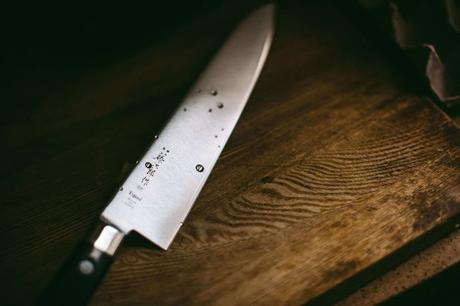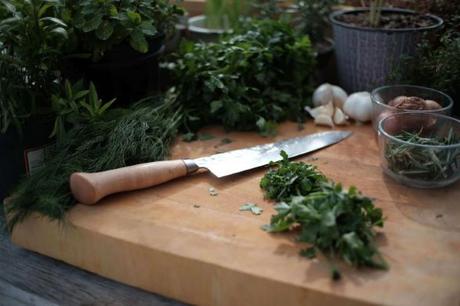
Maintaining your steel kitchen knives is crucial for their peak performance, with regular sharpening being a vital part of this upkeep. For those who take pleasure in hands-on care, a whetstone of the appropriate grit is indispensable.
Whetstones come in various grits, each intended for different kinds of knives. So, whether you’re sharpening a standard kitchen knife or a custom knife, it’s paramount to choose the correct grit to match your particular blade.
Traditionally, whetstones were the go-to for sharpening Japanese knives, but they have proven equally effective on Western and custom knives. If you’re unsure about the right grit of whetstone to use for your kitchen knife, stay tuned. This article aims to provide comprehensive guidance to help you select the ideal grit for sharpening your kitchen knives.
What exactly is the grit of a whetstone?
Before we delve into the optimal grit for kitchen knives, it’s crucial to grasp what “grit” truly signifies. The grit of a whetstone represents the degree of its surface abrasiveness.
Generally, a higher grit value denotes smaller abrasive particles on the stone’s surface. For instance, a whetstone with a 400-grit rating will possess significantly larger abrasive particles compared to an 800-grit stone. Consequently, your choice of grit plays a pivotal role in the effectiveness of your knife sharpening.
Whetstones with smaller grits are highly abrasive and thus remove a substantial amount of metal from the knife’s edge with each pass. While this might initially seem advantageous, it’s vital to recognize that excessive metal removal through low-grit stones can often harm the blade.
Therefore, employing the correct grit of a whetstone, specifically suited for sharpening kitchen knives, not only ensures the right degree of sharpness but also helps to extend the blade’s lifespan.
What grit to use for kitchen knives?

Now that you know what grit means, it is time to explain what grit is best for sharpening kitchen knives. The short answer to this question is that the grit you will use simply depends on the condition of your blade. Here are the three grit ranges that can be used for different kinds of knives:
1000 girt or less
As mentioned in the previous section, lower grits are going to be more abrasive with larger particles. Therefore, a grit that is rated for 1000 or less is going to be ideal for sharpening an extremely dull knife that has lost its edge.
Since a highly abrasive whetstone is going to remove more metal, it can bring a worn or dull kitchen knife back to life. A dull knife is going to have deeper nicks and cracks on its edge, which can be removed by a low-grit whetstone.
With that said, if your knife is not dull or extremely worn, you should avoid using whetstones that are rated for 1000 grit or less. That is because if your knife is relatively sharp and needs just a small amount of sharpening to perfect its edge, a highly coarse grit is going to do more harm than good.
Therefore, whetstones with a grit rating of 1000 or less should be reserved for old, worn, or extremely dull kitchen knives that you want to revive.
1000-3000 grit
The second grit range that is commonly used for sharpening kitchen knives is the 1000-3000 grit range. Whetstones that are rated for this grit range are less abrasive compared to one’s rated for under 1000. Therefore, the smoother surface of 1000-3000 grit doesn’t remove a lot of metal from the knife surface.
Since this grit range is gentler on the knife, it is ideal for knives that are not damaged but may be slightly dull and need a bit of sharpening to regain their peak sharpness. So, if you are looking for a whetstone to help you sharpen a dull knife and get it into cutting condition, then the 1000-3000 grit range is ideal for you.
But bear in mind that relying only on this grit range for sharpening your knife can also damage your knife because 1000-3000 grit range is not ideal for edge maintenance.
4000-8000 grit
Once you reach the 4000-8000 grit range, you are now entering the least abrasive grit range. This grit range is ideal for refining your kitchen knife’s blade to get it to the razor-sharp finish that every chef looks for.
So, if your goal is to get the knife as sharp as possible without damaging the knife, then the 4000-8000 grit range is it. Even within this grit range, the whetstones rated for 4000-5000 grit are ideal for fine sharpening of the edge. The grits between 5000-8000 should be reserved for adding extremely fine detail to the knife’s edge.
In short, whetstones that range between 5000-6000 range are ideal for polishing the edge of the blade, and those between 6000-8000 range are good for super fine polishing.
When you are sharpening a kitchen knife, there is no single grit range that you can use for every single knife. Instead, the choice of grit depends entirely on the condition of your knife and its usage purposes.
To sum it all up, use a 1000 grit or less on a knife that has lost its edge, and if you want to restore an edge on one of your old knives. Use 1000-3000 grit to get a dull knife in useable condition. And finally, use a 4000-8000 grit whetstone to refine the edge of a regular knife and make it as sharp as possible.
If you are new to whetstones, then getting a two sided whetstone would be a better choice. For example, if you get a two-sided whetstone with a 3000 grit rating on one side and 6000 on the other side, you can use the same stone to sharpen and refine the same knife.
Conclusion
Kitchen knives are used everywhere, from home kitchens to restaurants, and keeping them sharp is essential for cooking great recipes.
Now that you know what different grits are available and how to use each grit range for sharpening a kitchen knife, you are ready to start maintaining them.
